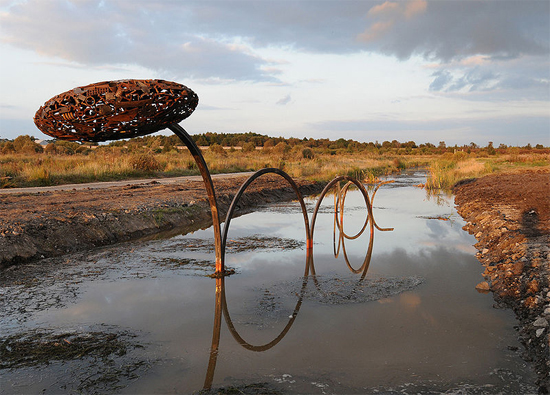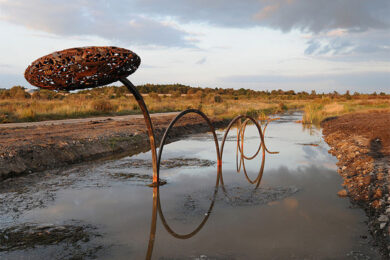System No. 30 by Julian Wild, at Lough Boora
A couple of weeks ago I went with my parents and the dog to visit the Lough Boora Parklands, a large swathe of reclaimed bogland. It’s not far from where Ireland’s first milled-peat fired power station once stood, though the twin chimneys that once dominated the horizon for miles around were knocked down in 2003 and the small locomotives that pulled carriages full of peat across the bog are no more. While the practice continues elsewhere in the country, the 2000 hectares of land around Lough Boora are providing the first real-world example of what might happen to the bogs that dominate the Irish midlands once they have been used to their limit. In the coming decades, more and more of these cutaway bogs will fall out of commercial use, and what happens next is of great ecological and social importance to a huge portion of Irish land.
In Lough Boora, the answer has been to create a public park, waterways and bird sanctuary. At the heart of the park’s attractions is a series of commissioned sculptures. The project began with eight site-specific sculptures in 2002 and has now grown to more than double that. The brief is pretty clear: work that is made from and inspired by the materials of the bog itself and its recent industrialised past. Some are large and very much aware of the land’s history, such as Michael Bulfin’s Sky Train or Maurice MacDonagh’s Raised Line. Others are smaller and seemingly more personal, Marianne Jørgensen’s Happiness and Secret Garden for instance, where big words are carved into, or out of, the land – "Happiness", "Love", "Hate", "War", "Peace". Others are essentially abstract figures – the bending arrows of Cycles, the swirl of Boora Convergence, the stark 60 Degrees.
The works come and go; some are designed to be temporary, and some have been there for over a decade at this stage. In that time, what was once an area of clear paths and unrestricted views has become, in parts, overgrown and enclosed. Where once there was an open air gallery, there is now a maze of thickets from which sculptures sometimes emerge, often radically changed from their original presentation. The spectacle of the work is diminished, and the degree to which the land has reclaimed the sculptures becomes the most interesting thing about the experience of being there. Jørgensen’s works have almost disappeared completely, nearly every trace scattered by the wind. MacDonagh’s Raised Circle is hidden in a growth of high summer grass, set to reappear once winter comes. Many of those that remain clear seem like impositions by comparison; bald statements of human intent where the overgrown and weather beaten are becoming one with the place, neither fully human nor fully bog.
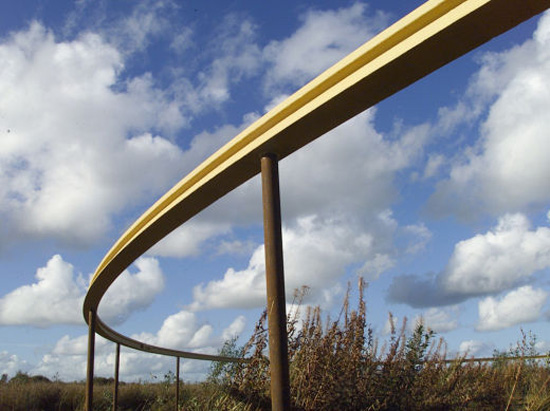
Raised Circle by Maurice MacDonagh, at Lough Boora
I was at the Hilltown New Music Festival about six weeks ago. The festival took place over two days at Hilltown House, a small estate nestled in the hills of Co. Westmeath, a short stretch of dangerous road north from the town of Castlepollard. During the year, the house serves as a retreat, inviting artists to come and work in the solitude and peacefulness such a remote location provides. For the festival, a re-purposed barn played host to the visiting musicians, mostly performing rather dry, academic forms of contemporary composition. I went along to see Richard Skelton, who was performing with his partner Autumn Richardson as AR. For years now, Skelton’s work has been in constant communication with the landscape, his music and printed material exploring the relationship between people and the land they inhabit, in a way that is thoughtful, beautiful and complex. Whether through the intertwined language, landscape and personal narrative derived from the West Pennine Moors of northern England in Landings or the wild wind of the Atlantic Irish coastline in Verse Of Birds, Skelton’s music often achieves a rare connection with the world around it.
As well as the live performances, the festival grounds included multimedia installations by artists present and not present, as well as a listening room which played compositions culled from an open submission process. For their installation, Skelton and Richardson laid claim to the castle keep, a derelict tower of ancient stone now filled with ivy, nettles, trees, bugs, birds and nests; a space once for human use and now not. The pair cordoned off the keep, listing the names and translations of the plants they found there in a little booklet attached to the chicken wire keeping us all out. Inside the keep, a recording of birds made in the space was played back over some speakers. Their stated aim was to draw attention to that which would normally go unnoticed, especially at a music festival.
A few days after the festival, Skelton updated his blog with a piece of critical reading, first outlining the reasoning behind the work and then, piece-by-piece, questioning the success of each aspect of it. It is rare to see such an honest piece of artistic self-criticism in public, and rarer still to see it a week or so after the work itself was made. The questions Skelton asks of himself are extremely pertinent, going to the heart of what makes a piece of environmental art successful. The main concern is the artist’s own intrusion on the space – how much damage was done in the process of recording and documenting the space? Is it hypocritical to cause this damage and then demand that others stay out of the space? Did the artist’s intentions usurp the natural life of the place? Would the space have been better off if they had just left it alone?
His conclusion is the question that every artist working in natural space has to consider – "how can we draw attention to something without intruding, or upsetting the delicate balance that already exists?"
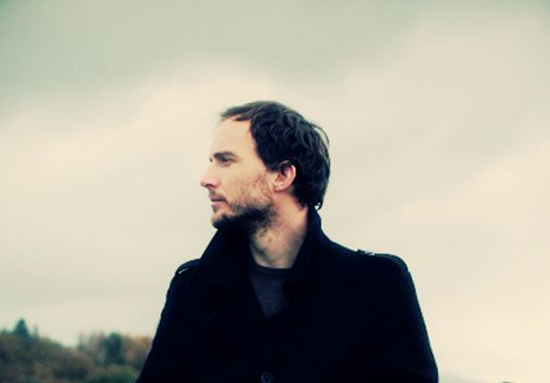
Richard Skelton
In an article in the Guardian a few months ago, Steven Poole attempted to highlight the bourgeois character of contemporary nature writing. He figured that there is an insurmountable divide between the often harsh reality of the natural world, seen as a haven of essential, unquestionable authenticity, and the comfortable, compromised life of the urban middle-classes who are almost always the target audience of such writing. On that front, it is hard to doubt him. There is indeed a wealth of literature out there dedicated to giving mild country kicks to the otherwise city-bound, sugar-sating our hunger to live an authentic life, but in his attempt to ascribe a right-wing ideological bent to that writing, Poole’s argument hollows out.
"In an era of immigration anxiety," he says, "the ubiquitous ecological rhetoric of "native" and "invasive" species projects on to the natural world the patterns of human geopolitics. People talk of the grey squirrel as though he were the Middle Eastern asylum-seeker or eastern European plumber of tabloid hate-mongering, come over here as a benefits tourist or cunning job-thief."
He attempts to conflate worries about invasive species in unprotected environments with "anti-immigration demagogues [who] claim that foreigners will destroy a unique and distinctive British culture."
"Projects" is the key word here. Poole is projecting human social concerns onto matters of ecology that have nothing to do with lines on a map or the colour of someone’s skin. Poole extrapolates an ideological element he disagrees with and, in the process, obscures the environmental one he is supposedly trying to draw attention to. He falls down in much the same way as many of the writers he criticises, discussing nature as an extension of human consciousness, of the human world, rather than something at least partly distinct from our personal conceptions of it. At the same time, nature is kept at arm’s length, something we cannot know and cannot be of. If we believe Poole’s argument, there is no way for the human to find itself in genuine communication with nature.
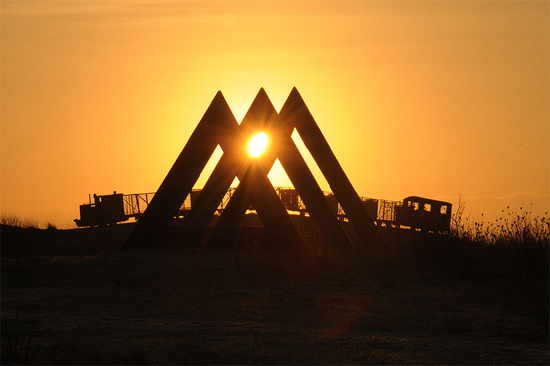
60 Degrees by Kevin O’Dwyer and Sky Train by Mile Bulfin, at Lough Boora
On the boglands at Lough Boora, we are in a transitional space somewhere between an industrial past and naturalist future. The art that occupies this space has the power to map the physical and philosophical bridge between human and non-human use of an environment and, as such, it must be in dialogue with both of these ideas at once. When a sculpture does not dominate the land it has been made to stand on, then the artist is not putting their intentions above the natural movement of the world they are living and working in. Skelton seems to have felt that domination in his work at Hilltown, a speaking for rather than a speaking with, which ultimately cost the work its conceptual foundation. The argument taking place in Poole’s article (and just as viciously in the comments below it) is one of boundaries; knowing where our consciousness ends and where nature begins. Figuring out how to cross that line in a way that is not polemical but illuminating and beneficial to both sides is the purpose of the artist.
In this part of the world, our relationship with the non-human, non-built environment continues to change, perhaps influenced most strongly now by a sense of global connection and more local social fragmentation. A dispossession, in the practical and philosophical senses, is occurring – our cities feel less and less our own, to the point where they need to be re-Occupied, and the country is something distant from most, almost incomprehensible as a site of life. There is a need, I feel, for art that can embody the ongoing story of that dispossession, but also perhaps strike at the heart of what can be regained. The way Skelton combines language and space in personal, historical, cross-platform narratives, the way MacDonagh’s Raised Circle appears through the grass – there is something in these things which is of two worlds, carrying the past into a possible future.

